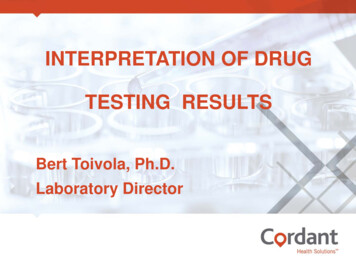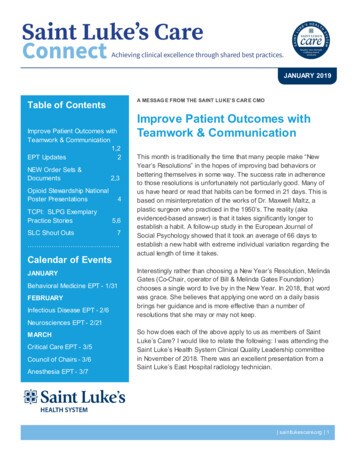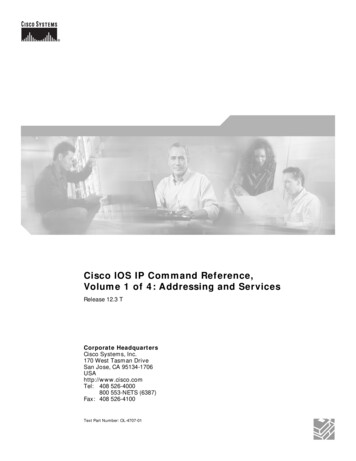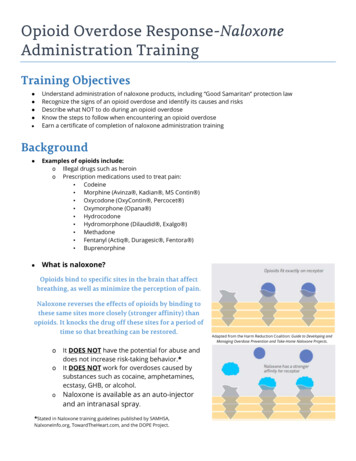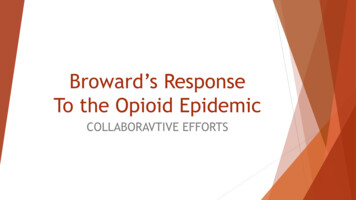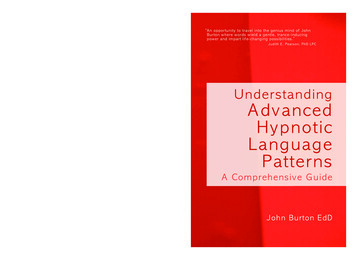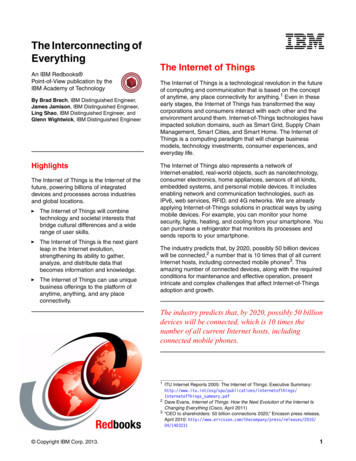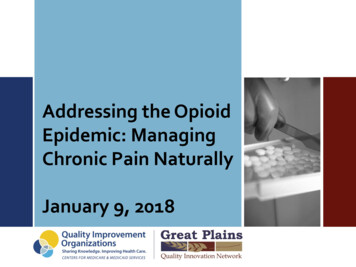
Transcription
Addressing the OpioidEpidemic: ManagingChronic Pain NaturallyJanuary 9, 2018
Five Pillars
Objectives Describe nonpharmacologic therapies formanaging chronic pain Understand implementation strategies ofnonpharmacologic therapies with patients forpain management3
Importance of NonpharmacologicTreatment CDC Guidelines for Prescribing Opioids forChronic PainSource: CDC Guidelines for Prescribing Opioids for Chronic Pain. m4
Today’s SpeakerJane Murray, MDSastun Center ofIntegrative Health CareOverland Park, KSwww.sastuncenter.com
Managing ChronicPain NaturallyJane Murray, MD – Medical DirectorSastun Center of Integrative Health Care
CHRONIC PAIN Chronic pain affects more than 100million Americans – more than heartdisease, cancer and diabetes combined 50 million Americans take some kind ofchronic pain medication
OPIOID USE IN THE U.S. In 2012, over 5% of U.S. population 12 years orolder used opioid pain relievers non-medically 14.4% of women are prescribed opioid duringpregnancy Five-fold increase in treatment admissions forprescription pain relievers between 2001 and2011 (35,648 to 180,708). US accounts for 100% of hydrocodone (e.g.,Vicodin) and 81% for oxycodone (e.g., Percocet)used globally.
WHAT IS PAIN? “An unpleasant sensory andemotional experience arising fromactual or potential tissue damage.” International Society for theStudy of Pain, 2004
ACUTE vs CHRONIC PAIN ACUTE PAIN 6 months Etiology known and understood Anticipated time-limited course CHRONIC PAIN 6 months Initial etiology may be a distant problem and nolonger a factor No end in sight
ACUTE PAIN Normal response to tissue damage, resolvessoon after tissue healing Activates pain-sensing and pain-relievingpathways Signs of increased autonomic activities(sweating, fast heart rate, increased bloodpressure) Responds well to pain medications and nonpharmacologic therapies
CHRONIC PAIN No protective function, lasts beyondtime expected for normal recoveryfrom injury Malfunction of nociceptive system Rarely accompanied by signs ofincreased autonomic activity
Chronic Pain is Complex
PAIN AS A STRESSOR Pain is perceived as stress Stops DNA repair Stimulates adrenal glands to secretecortisol and epinephrine Nociceptive (pain perceiving) andaffective (emotional) pathways coincideanatomically – so pain causes depression,and depression magnifies pain
PAIN PERCEPTION Cortex Thinking Memories Attention Suggestion What you feelas pain Limbic system Moods &behaviors Instincts Depression,anxiety,irritation
Breaking the cycle of chronic pain maytake many strategies. The cycle must bebroken to reduce/minimize the pain.
CHRONIC PAIN ANDNEUROPLASTICITY Brain receives signals from spinal cord Brain then undergoes changes in neuronalconnections that may permanently strengthenits reactions to those signals This process may be the key to thedevelopment of chronic pain BUT this process may also be reversible
The mind is good atanything you teachit (neuroplasticity).It has tremendouspower to help withhealing. It needstraining.
Cognitive behavior therapy Breathing techniques Movement/graded exercise Sleep modification Yoga & yoga therapy, T’ai Chi, Qi Gong Meditation/mindfulness Acupuncture Massage/body work/myofascialtechniques/craniosacral therapy Feldenkrais, Hellerwork, Rolfing, AlexandertechniqueNon-pharmacologic Approaches
Biofeedback/neurofeedback/hypnosis Stress reduction Balancing neurotransmitters with targeted amino acidtherapy Nutraceuticals to improve genetic defects,mitochondrial insufficiency Anti-inflammatory diet Hormone balancing EMDR and other psychotherapies for PTSD-associatedpain Music Herbal anti-inflammatories Infrared sauna Energy medicine, therapeutic touch
The number one reasonpeople seek complementarytherapies PAIN
Yoga & Yoga Therapy
YOGA TOOLS FOR MANAGING PAIN IN THE PHYSICAL BODY:Asanas or yoga poses or postures - to correct imbalance ofthe physical body.1st Layer: Physical Body(Annamaya)
The Vagus Nerve is themechanism for slowingdown the body. It is thebrake which allows thebody to move fromSympathetic (flight orfright or freeze) toParasympathetic (restand digest)BREATHINGTECHNIQUES activatethe Vagus Nerve
Acupuncture
Acupuncture NIH Consensus Conference onAcupuncture (1997) reported efficacy ofacupuncture for a variety of healthproblems, including Osteoarthritis Low back pain Myofascial pain Fibromyalgia
Acupuncture for Migraine Cochrane review 22 trials (n 4985) concludedthat the available evidence suggests addingacupuncture to symptomatic treatment ofattacks reduces the frequency of headaches.The available trials also suggest: That acupuncture may be at least similarly effective astreatment with prophylactic drugs. “Acupuncture can be considered a treatment option forpatients willing to undergo this treatment.” Linde K, et al. Acupuncture for the prevention of episodicmigraine
Natural Substances for Migraine Magnesium Riboflavin Butterbur Feverfew CoQ10 Turmeric
Spinal Manipulation for Acute Back Pain 15 randomized controlled trials (more than1,700 patients) found spinal manipulationcaused an improvement in pain of about 10points on a 100-point scale 12 RCTS, some of which overlapped withabove but not all, ( 1,400 patients) foundspinal manipulation resulted inimprovements in function
Clinical Practice Guidelines for Back PainAmerican College of Physicians - 2017 For patients with chronic low back pain,clinicians and patients should initiallyselect non-pharmacologic treatment withexercise, multidisciplinary rehabilitation,acupuncture, mindfulness-based stressreduction (moderate- quality evidence),tai chi, yoga, motor control exercise,progressive relaxation, electromyographybiofeedback, low-level laser therapy,operant therapy, cognitive behavioraltherapy, or spinal manipulation (lowquality evidence)
Fascia Fascia is a fibrous tissue that surrounds bone, musclegroups, blood vessels and nerves Fascia binds structures together while allowing themto slide across each other. Fascia can be classified depending on where it isfound in the body - superficial, deep or visceral Fascia is made up of collagen and elastin fibers alongwith a gel like compound called Ground Substance
Fascia Fascia is continuous throughout the body Unlike muscles, fascia does not stop at origin andinsertion points The tensions that occur when muscles contractmuscles contract cross the joints through thefascia
When pain is presentNo one wants to be in pain, so we try toavoid it Position our body so the pain is lessenedShorten our strideReduce our ability to reachReduce our ability to turn and twistREDUCES MOBILITY
When pain is presentCompensation Postural Distortion Compensation occurs depending on where the pain is located Compensation usually follows a crossing pattern Recruitment fatigue (muscles like routine)The longer pain and compensation patterns are present themore likely your body will accept the new posture as normalPain signal overload: “I didn’t know that hurt”
Exercise/Activity - Fibromyalgia Graded, “energy bank” concept Water exercise Walking Goal is 40 min 5-7 days a week Adequate rest
Avoid Opioids in Fibromyalgia Opioid pain receptors are blocked in FM,so these drugs are not appropriate They may help patients based on theirpotential antidepressant effect
Exercise - Arthritis Water aerobics, swimming, water walking Yoga, T’ai Chi, Qi gong “T’ai Chi has statistically significant benefits onlower extremity range of motion, especiallyankle ROM in people with tm Controlled trial of elderly OA patients for 12weeks enhanced quality of life, functionalmobility and arthritis self-efficacy with T’ai Chi J Am Geriatr Soc 2000 Dec;48(12):1553-9
DIET AND INFLAMMATION Inflammation in the body is often driven byeating an anti- or pro- inflammatory dietarypattern; inflammatory mediators can impactpain, mood, sleep, functioning An anti-inflammatory diet reducesinflammation and improves health The Dietary Inflammatory Index is based onmeasuring inflammation in the body inresponse to foods; it has been used in numerouspublished studies and is being studied for use asa clinical tool (DII Screener free app)
Nutritional Approaches - Arthritis Essential fatty acids, olive oil, fish, nuts, seeds Avoid inflammation-promoting fats: PUFA’s (safflower, sunflower, corn oil); margarine,vegetable shortening, partially hydrogenated oils(in snack foods)Eliminate dietary allergens (especially wheat, corn,dairy, red meat)Green tea instead of coffeeVegetarian diet
Herbs & Natural Products
Anti-inflammatory Herbs Ginger 500-1000 mg powder twicedaily Curcumin (Turmeric) 400-600 mgthree times/day Feverfew? Topical capsaicin
Glucosamine Glucosamine stimulates production ofglycosaminoglycans in joints, thusbuilding cartilage; also promotes uptakeof sulphur into cartilage Aging results in decreased ability tomake glucosamine No food sources of glucosamine
Chondroitin Chondroitins are the main glycosaminoglycans in joints and connective tissue Hyaluronidase and leukocyte elastase(enzymes that break down cartilage) areinhibited by chondroitins Data supporting use for OA are good Side effects/toxicity rare Dose: 400 mg 3 times/day
S-adenosylmethionine (SAMe) Formed by combining methionine withATP Important for forming gel-like/shockabsorbing nature of cartilage Large study (20,641 patients) with OAknee, hip and spine given SAM for 8weeks: 71% “good or very good”improvement, 21% “moderate”, 9% poor;tolerance very good Berger & Nowak: Am JMed 1987;83:84-8
Sleep and Chronic Pain 50-80% of chronic pain patients have sleep disturbance; paincan interfere with sleep and sleep disturbance canexacerbate painThe presence of sleep-disordered breathing, includingobstructive sleep apnea and central sleep apnea, increasesthe risk of significant harm associated with the use of opioidsand other centrally sedating medicationsClinicians should have a sleep questionnaire readily availablein clinic to assess quality of sleep in all patients, butparticularly those with pain; appropriate follow-up withformal sleep study if needed. Cheatle MD, et al. Assessing and Managing Sleep Disturbance in Patients with Chronic Pain.Sleep Medicine Clinics, 2016;11(4): 531-541Copyright Integrative Medicine Concept, LLC. All Rights Reserved.
Sleep Enhancement Herbs: valerian, passion flower, melissa,camomile, lemon balm Aromatherapy: lavender, sage OTCs: benadryl, melatonin Targeted amino acids: taurine,phenylbutyric acid Bedtime ritual: bath, tea, relaxing activity
Mind-Body Approaches Emotional expression: RA patientsjournaling about past trauma averaged28% decrease in symptoms after 4months JAMA April 4, 1999 Hypnotherapy, guided imagery,visualization, biofeedback for pain Meditation, yoga, breathwork
John Sarno, MD – “Healing Back Pain”Scott Brady, MD – “Pain Free for Life” Suppressed feelings of anger, fear, anxiety, shame, guilt canbe potent contributors to chronic low back pain“Deep journaling” about these feelings can be therapeutic“Fear of pain” can perpetuate immobility and pain – peoplemust move through the painChronic pain medications will not be the answer in thesesituations
Muscle Relaxation Stretching Herbs: arnica (topically), valerian Body work: massage, Feldenkrais,muscle balancing
HORMONE THERAPY Estrogens may be enhancers of humoralimmunity Progesterone and androgens are naturalimmune suppressants Low DHEA, DHEA-S, testosterone andDHT found in RA patients Androgen therapy may be helpful Rheum Dis Clin North Am 2000Nov;26(4):881-95
A word about the limbic system
The AMYGDALA is the instinctualfear center
When overstressed, the limbic systemcontinually activates chemicals, hormones,immune defenses of fight/flight, poordetoxification, reduced immunity andongoing hypersensitivity to pain
Limbic Rehabilitation may be theanswer for some people “Wired for Healing” – Annie Hopper Dynamic Neural RehabilitationSystems www.dnrsystems.com
Knowing Our Purpose “We have more conveniences but less time. We havemore degrees, but less sense.more knowledge butless judgment; more experts, but more problems; moremedicines, but less healthiness “We have been all the way to the moon and back buthave trouble crossing the street to meet the newneighbor.” “We build more computers to hold more informationthat produce more copies than ever before, but we haveless communication.” “We have become long on quantity, but short on quality.These are the times of fast foods, but weak digestion.It is a time when there is much in the window butnothing in the room.” Attributed to The Dalai Lama
Meaning and Purpose What truly gives a person a sense ofmeaning and purpose in life? How can someone discover her lifepurpose to focus on the essence of whoshe is? Her be-ing. How can one live from a “deep place”despite his or her pain? So important to explore.it is often thekey to less suffering.
“ He who has a why forlife, one can put upwith almost any howFrederick Neitzsche”
Pain is inevitable.Suffering is optional.
And humor can be goodmedicine .
Contact Information jmurraymd@sastuncenter.com (913)345-0060 www.sastuncenter.com
Questions63
Medication Safety LANUpcoming Events Managing Chronic Pain Naturally– Coaching Call: January 29, 12:15 to 12:45 p.m. ll-managingchronic-pain-naturally/?instance id 1442 Chronic Pain Management at a Family MedicineResidency– Webinar: February 6, 12:15-12:45 p.m. CT– Coaching Call: February 20, 12:00-12:30 p.m CT Nebraska State Pain Guidance Document– March and April 201864
Contact InformationAmanda Bridges, MBASally May, RN, BSN, CH-GCNProject Managerabridges@kfmc.orgKansas Foundation for Medical Care800 SW Jackson St, Ste 700Topeka, KS 66612P: 785.273.2552, Ext 349Senior Quality Improvement Specialistsally.may@area-a.hcqis.orgPaula Sitzman, RN, BSNQuality Improvement Advisorpaula.sitzman@area-a.hcqis.orgCIMRO of Nebraska1200 Libra Drive, Suite 102Lincoln, Nebraska 68512P: 402.476.1399, Ext. 512Jayme Steig, , PharmD, RPhQuality Improvement Program Managerjayme.steig@area-a.hcqis.orgQuality Health Associates of North Dakota41 36th Ave NWMinot, ND 58703P: 701.989.6220Linda Penisten, RN, OTR/LProgram Managerlinda.penisten@area-a.hcqis.orgSouth Dakota Foundation for Medical Care2600 West 49th Street, Suite 300Sioux Falls, SD 57105P: 605-444-412465This material was prepared by the Great Plains Quality Innovation Network, the Medicare Quality Improvement Organization for Kansas, Nebraska, North Dakota and SouthDakota, under contract with the Centers for Medicare & Medicaid Services (CMS), an agency of the U.S. Department of Health and Human Services. The contents presenteddo not necessarily reflect CMS policy. 11S0W-GPQIN-ND-C3-164/0118
John Sarno, MD –“Healing Back Pain” Scott Brady, MD –“Pain Free for Life” Suppressed feelings of anger, fear, anxiety, shame, guilt can be potent contributors to chronic low back pain “Deep journaling” about these feelings can be therapeutic “Fear of pain” can perpetuate i
